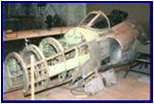

|
Supermarine Swift |
|
Two Supermarine Swift prototypes to specification E.41/46 (VV106 and VV119) were ordered 0n the 13th March 1947 and were built as Type 510 and 535 respectively. There then followed a number of contracts for pre-production, Mk1, Mk2, Mk3, Mk4, FR.5, F.4, PR.6. FR.6, and F7 for a grand total of 499 aircraft, but of these only 193 aircraft plus 4 prototypes were built the remainder being cancelled at various times. The main reason for cancellation of the Swift was that orders for interceptors overstretched the available national finances and were incompatible with the end of the fighting in Korea. If both Swift and Hunter production had continued, the peak delivery of 50 fighters a month would have been excessive for peacetime requirements. In fact both programmes were cut back and ultimately the Swift was discontinued altogether. However the Swift had met its operational requirements and its aerodynamic shortcomings were just being overcome. The Swift FR.5 proved that as a low-level reconnaissance aircraft it could not be beaten even by the Americans. There were no structural failures in the Swift fleet. They were also the first British operational aircraft to use a reheated engine, laying the ground-work for the application of the same basic engine to be used in the later Lightning fighter. The fighter reconnaissance Swifts (FR.5) did a great deal of pioneering work flying at low levels under the radar screen. This was very demanding structurally and the Swift’s robust construction stood up extremely well. Unique methods devised by the Royal Aircraft Establishment for extending the life of such dive-bombers and tested by Supermarine proved invaluable in the subsequent development of terrain-following techniques and in the integrity of airframe strength under repeated high g dive-bombing manoeuvres.
|




|
Boscombe Down Aviation Collection—Old Sarum Airfield |
|
Restoring the past for the future |